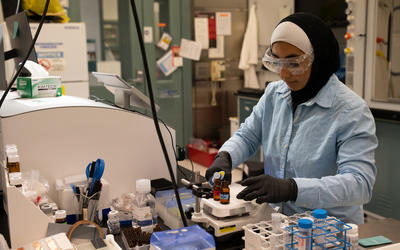Additive manufacturing (AM) is causing fundamental changes in the way mechanical parts are produced. Where typical manufacturing operates by cutting away or molding material, additive manufacturing uses digital designs to fabricate three-dimensional products that are built up layer by layer. This process, also known as 3-D printing, can produce complex designs using less material and generating less waste than traditional manufacturing.
As the field matures, comprehensive measurements and standards will be critical for expanding AM use by industry. Through its core missions of measurement science research and standards development, NIST is working with U.S. industry to lead these manufacturing transitions.
The Engineering Laboratory’s Measurement Science for Additive Manufacturing (MSAM) program is exploring barriers to adoption of additive manufacturing, such as surface quality, part accuracy, fabrication speed, material properties and computational requirements. To mitigate these challenges, the program focuses on material characterization, real-time control of additive manufacturing processes, qualification methodologies and system integration.
The Material Measurement Laboratory's Additive Manufacturing Program is investigating additive manufacturing-related issues for several material types (metals, polymers, ceramics, and biomedical materials). MML AM studies materials to better understand their characteristics, behaviors, and applications. The MML uses these understandings to develop standard reference materials (SRMs) for researcher and industry use. These understandings and reference materials benefit U.S. commerce and competitiveness by providing vital information for increasing efficiency in U.S. manufacturing.
The Physical Measurement Laboratory is studying emissive properties of materials in solid, powder, and liquid states, as well as improved techniques for real-time temperature measurements to support better understanding and modeling of additive manufacturing processes.
The Research
Additional Resources Links

Social Spotlight: Jake Benzing and Electron Backscatter Diffraction
This image screams “manufacturing,” right? For NIST’s Jake Benzing, they certainly do.
With an electron microscope by his side, the NRC postdoctoral fellow creates scans like these for 3D-printed cubes made from different metal alloys. The cubes come from a process called additive manufacturing, which builds up a 3D shape from thin layers of metal powder, each melted into place by a laser or electron beam. Engineers want to control and understand the additive manufacturing process as much as possible, so that their creations can handle the real-world stresses that they’re supposed to withstand.
Find out more about Jake’s research:
- Effects of laser-energy density and build orientation on the structure–property relationships in as-built Inconel 718 manufactured by laser powder bed fusion
- Tracking defects and microstructural heterogeneities in meso-scale tensile specimens excised from additively manufactured parts
- Hot isostatic pressing (HIP) to achieve isotropic microstructure and retain as-built strength in additive manufacturing titanium alloy (Ti-6Al-4V)





